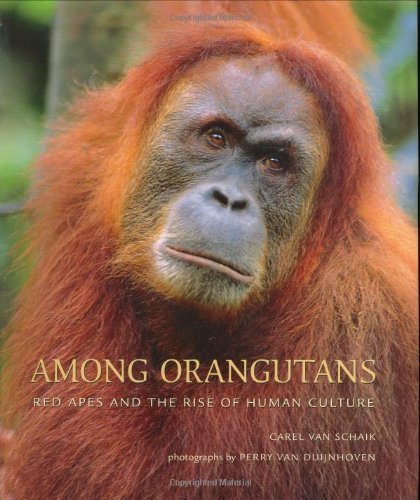Items related to Among Orangutans: Red Apes and the Rise of Human Culture

The local people know him as the "Man of the Forest," who refused to speak for fear of being put to work. And indeed the bear-like Sumatran orangutan, with his moon face, lanky arms, and shaggy red hair, does seem uncannily human; one of our closest relatives in the animal kingdom, the orangutan may have much to tell us about the origins of human intelligence, technology, and culture. In this book one of the world's leading experts on Sumatran orangutans, working in collaboration with nature photographer Perry van Duijnhoven, takes us deep into the disappearing world of these captivating primates.
In a narrative that is part adventure, part field journal, part call to conscience, Carel van Schaik introduces us to the colorful characters and complex lives of the orangutans who inhabit the vanishing forests of Sumatra. In compelling words and pictures, we come to know the personalities and temperaments of our primate cousins as they go about their days: building double-decker tree nests; using leaves as napkins, gloves, rain hats, and blankets, and sticks as backscratchers and probes; nurturing their infants longer and more intensely than any other nonhuman mammal. Here are the births and deaths, the first use of a tool, the defeat of a rival, the gradual loss of influence that, while fascinating to observe, may also help us to reconstruct human evolution.
"synopsis" may belong to another edition of this title.
Barbara Smuts is a professor in the psychology department at the University of Michigan at Ann Arbor. She is author of Sex and Friendship in Baboons (reprinted with a new preface, Harvard University Press, 1999). (1,029)
"About this title" may belong to another edition of this title.
- PublisherBelknap Press
- Publication date2004
- ISBN 10 0674015770
- ISBN 13 9780674015777
- BindingHardcover
- Edition number1
- Number of pages256
- Rating
Buy New
Learn more about this copy
Shipping:
US$ 4.00
Within U.S.A.
Top Search Results from the AbeBooks Marketplace
Among Orangutans: Red Apes and the Rise of Human Culture
Book Description Hardcover. Condition: new. New. Fast Shipping and good customer service. Seller Inventory # Holz_New_0674015770
Among Orangutans: Red Apes and the Rise of Human Culture
Book Description Hardcover. Condition: new. New. Seller Inventory # Wizard0674015770
Among Orangutans: Red Apes and the Rise of Human Culture
Book Description Hardcover. Condition: new. Buy for Great customer experience. Seller Inventory # GoldenDragon0674015770
Among Orangutans: Red Apes and the Rise of Human Culture
Book Description Hardcover. Condition: new. Prompt service guaranteed. Seller Inventory # Clean0674015770
Among Orangutans: Red Apes and the Rise of Human Culture
Book Description Hardcover. Condition: new. New Copy. Customer Service Guaranteed. Seller Inventory # think0674015770
Among Orangutans: Red Apes and the Rise of Human Culture
Book Description Condition: new. Seller Inventory # FrontCover0674015770
AMONG ORANGUTANS: RED APES AND T
Book Description Condition: New. New. In shrink wrap. Looks like an interesting title! 1.9. Seller Inventory # Q-0674015770
Among Orangutans: Red Apes and the Rise of Human Culture
Book Description Hardcover. Condition: New. Brand New!. Seller Inventory # VIB0674015770

